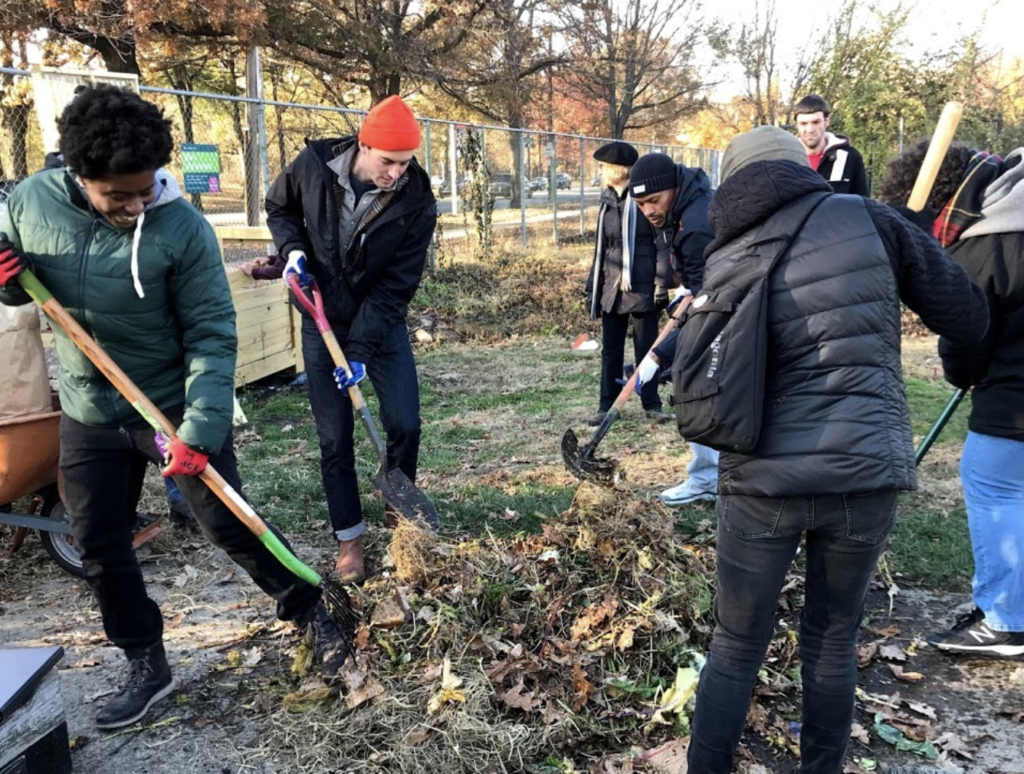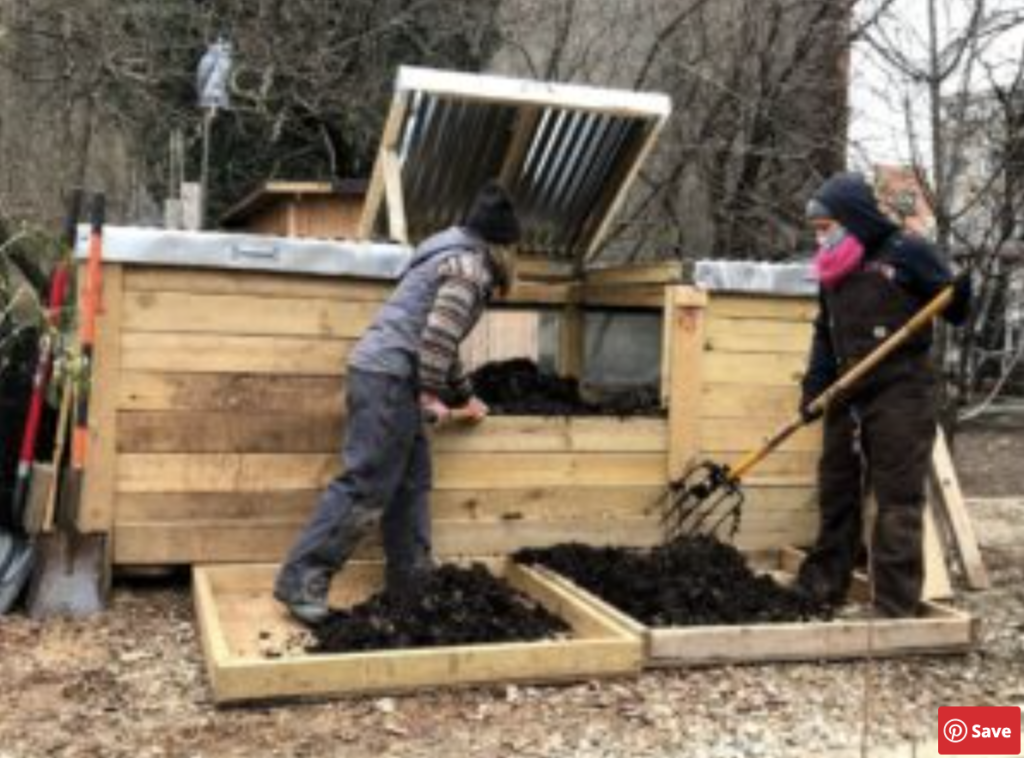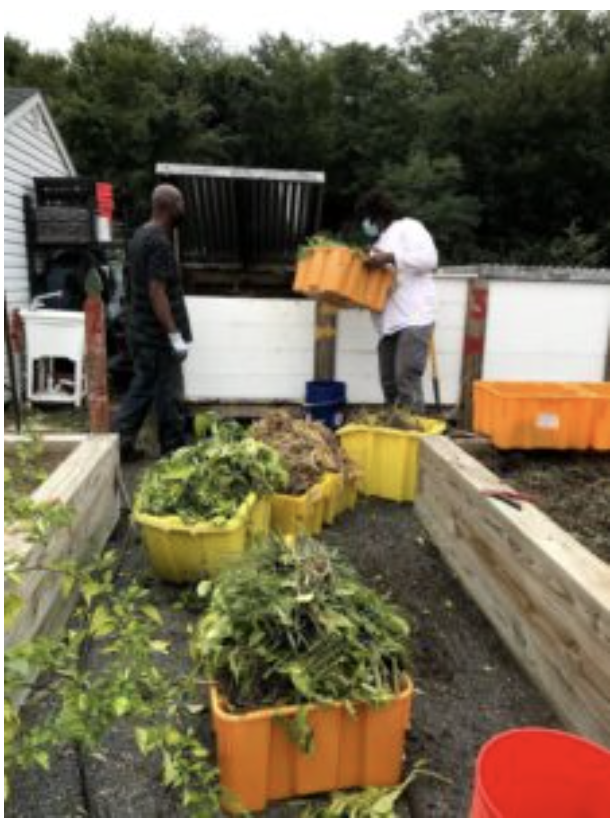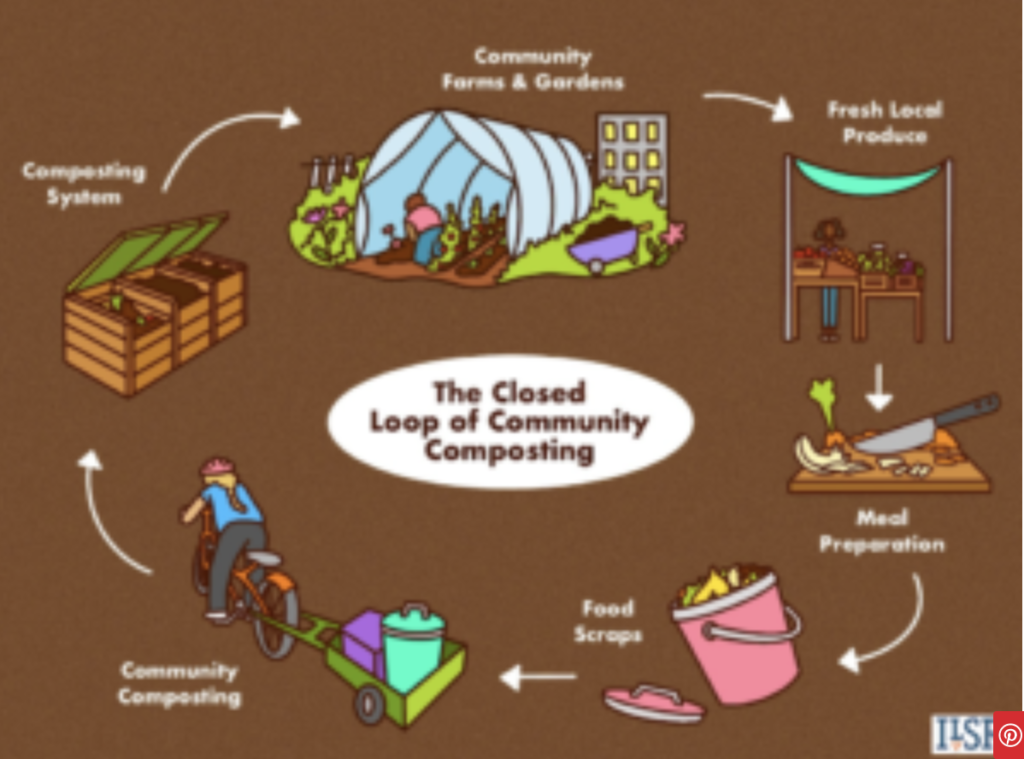Issues & Analyses: How To Start A Community Composting Project

Trainees at master composter course in Philadelphia practice building a compost pile together. Photo: ILSR
Editor’s note: Community composting projects are burgeoning around the country and here in Amherst we are just beginning to consider the possibilities for embracing composting as a community and in the process greatly reducing our waste stream. (see here). In the coming weeks we will run a series of articles to introduce the concept. The first comes to us c/o Shareable under a Creative Commons license. This article was orignally published on Shareable on June 23, 2021.
by Brenda Platt| June 23, 2021
Frustrated your town doesn’t offer a way for you to compost your food scraps? Don’t despair. Get active. Composting is a proven way to address problems like climate disruption. It cuts methane emissions at landfills, while storing carbon in soils.
When it takes place at the community level, it’s a terrific strategy for unleashing the power of collaboration and civic engagement to move toward a zero waste economy that puts people and planet first. Community composting is the not-so-radical idea that compost is used where it’s made and the community participates in some way.
Community-scale composters serve an integral and unique role in both the broader composting industry and the sustainable food movement. They are often social innovators and entrepreneurs. Many collect food scraps with bikes. Others employ youth and marginalized individuals. A growing number utilize cooperative ownership structures.
Community composters are located at schools, universities, community gardens, farms, and many other places – urban, rural, and suburban. Their distinguishing feature is keeping the process and product as local as possible while engaging the community through participation and education.
Interested in starting a project? Here are some tips for getting started.
1. Take a training course to learn why and how to compost

The single most important factor contributing to the success of a composting site is a trained operator. Composting is not rocket science, but you need to know the basics.
A course should teach the what, why, and how of composting. You’ll learn that compost is not soil, but a valuable soil enhancer teeming with beneficial microbes and rich in organic matter. You’ll learn the conditions under which materials will decompose quicker plus how to produce a high-quality mature compost that suppresses plant diseases and increases the capacity of soil to hold water and nutrients.
Composting is an aerobic process, which means it requires oxygen. Odors can result in starved oxygen conditions or improper recipes. For instance, you will need a supply of carbon-rich materials like fall leaves or shredded wood to compost with your nitrogen-rich food scraps.
Where to get training? Start by checking out the Institute for Local Self-Reliance’s Home Composting Website, which includes a Webinar – Composting at Home: An Introduction to the Basics. If you’re interested in a more in-depth course, search for “Master Composter” programs in your area. If none exist, consider advocating for one or bringing our Neighborhood Soil Rebuilders composter train-the-trainer program to your community. The US Composting Council offers basic training as do several state agencies.
2. Decide where you’ll compost and who to partner with

Volunteers members of the Compost Cooperative flip a compost pile at the Hidden Harvest Community Farm, Baltimore. Credit: ILSR
Do you have space to compost in your backyard or at your home? Even if you do, perhaps you’re drawn to this activity because composting is a way to bring neighbors together for a common cause, strengthen the community’s social fabric, and promote social inclusion and empowerment.
Community composting harnesses the power of volunteerism. It works well at locations that can use the compost produced. Thus, no surprise that many operations are sited at community gardens and urban farms (for instance, Red Hook Community Farm in Brooklyn, New York, and ECO City Farms in Bladensburg, Maryland).
Schools with youth gardens are excellent places to incorporate composting. Young composters become old composters! The Farm and Food Hub at Kelly Miller (Washington, DC) is a collaboration among the Kelly Miller Middle School, the nonprofit Dreaming Out Loud, the DC Department of Parks & Recreation, Loop Closing, and other community partners. Identify potential collaborators. They can bring opportunities, funding, expertise, material resources and equipment, land/space, good will, and buy-in.
3. Choose which stage of the composting process to tackle

One initial step is to identify why you’re interested in a community composting project and what you hope to achieve. Are you composting to engage youth or community leaders in the art and science of composting? Are you working to close the loop on your local food system? Answering these questions will help you establish the scale of your program, determine where to look for resources and partnerships, and determine the necessary program components.
Composting food scraps at The Farm and Food Hub at Kelly Miller. Credit: ILSR
Every composting arrangement includes someone who develops and coordinates the program, someone who generates the material to be composted, someone to collect it, someone to undertake the actual composting process, and someone to utilize the finished compost. You may fit one or all of these composting roles.
Most composting programs involve collecting or receiving materials in some fashion, thus, material handling considerations are important. Material collections can be “drop-off” or “pick-up.” In both cases, your customers or participants need a place to put source-separated materials throughout the week. Will you provide containers or ask your customers to find and use their own containers?
If you opt to offer collection service, you will need to decide by what means you’ll pick up: by bicycle, personal vehicle, neighborhood electric vehicle, van, pick-up truck, or other truck.
Do you want to form a new organization? What entity structure will you choose? Your choices extend beyond just for-profit versus non-profit. Members of the Community Composter Coalition include 501(c)3 tax-exempt organizations, worker-owned cooperatives, Certified B Corporations, and local governments. Check out the webinar ILSR hosted with the Sustainable Economies Law Center on Entity Structure for Community Composters for a deeper dive.
Fortunately, there are a number of resources to help you get started:
- Community Composting Done Right: Our Guide to Best Management Practices (by ILSR)
- Growing Local Fertility: A Guide to Community Composting (by ILSR)
- Community-Scale Composting Systems: A Comprehensive Practical Guide for Closing the Food System Loop and Solving Our Waste Crisis (by James McSweeney)
- The Worm Farmer’s Handbook: Mid- to Large-Scale Vermicomposting for Farms, Businesses, Municipalities, Schools, and Institutions (by Rhonda Sherman)
- Guide to Composting Onsite at Schools (by ILSR)
4. Become an advocate for community composting

If you don’t have the time or inclination to start a community composting project, you can exercise your civic power to advocate for policies and programs. Push your local planners and elected officials to support local composting infrastructure and to directly fund community scale equipment and programs. They can provide technical assistance and training. They can also support reasonable policies and regulations, procure finished compost, contract with micro-haulers and processors, and provide long-term access to land.
Related stories:
- Community composting grows from seed into a movement
- New York City newspaper boxes get new life as compost bins
- Compost Pedallers turn food waste into a boon for local communities
ABOUT THE AUTHOR
Brenda Platt
Brenda Platt directs the Composting for Community Initiative at the national nonprofit Institute for Local Self-Reliance, where she has worked 35 years promoting zero waste, non-burn solutions to trash. Her
